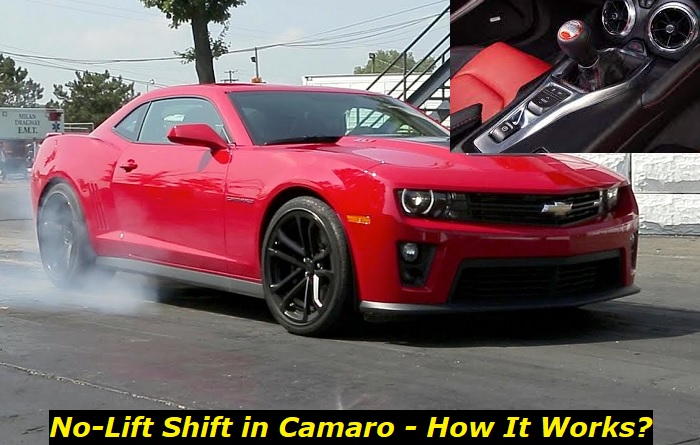One neat feature of the manual variant of the Chevrolet Camaro is its integration of a No Lift Shift (NLS) system. For many, this is the best way to fully experience what the car has to offer especially on the track or the freeway.

In this article, we will discuss the ins and outs of this feature, particularly in its application in the Camaro. Among the topics that we will tackle here are the following:
- What is the No Lift Shift in the Camaro?
- How It Works
- Key Benefits of No Lift Shift in the Camaro
- Most Common Problems with the No Lift Shift of the Camaro
What is the No Lift Shift in the Camaro?
The No Lift Shift is a General Motors propulsion technology that allows manual transmission drivers in cars like the Camaro to maintain their gas pedal fully depressed while upshifting. NLS manages torque during wide-open-throttle acceleration, allowing for a "flat-footed" upshift. To properly execute a no-lift shift, the driver must keep the gas pedal down and shift at the right RPM levels.
In general, the no-lift shift is a great way to get the most out of your car, and it's especially useful in racing applications. By keeping your foot on the gas during upshifts, you can maintain boost pressure and engine speed, which makes for a quicker and more responsive car. Many professional racers use the no-lift shift to get an edge on the competition.
How It Works
No Lift Shift facilitates the execution of a rapid, yet consistent upshift by controlling the engine's speed. According to GM's Al Oppenheimer, who was then the Chief Engineer of GM and has become known for developing the Camaro, the engine management system maintains throttle open for both boosted and non-boosted applications when encountering Engine Over-speed Protection during a shift.
In engineering terms, the activation of the system allows immediate torque control, with fuel and spark, for a set time. Then, the software utilizes a predictive control to manage torque with the throttle. All these allow the driver to take advantage of fast torque control for a short period of time without heating up or damaging the catalyst as it goes.
The exec explains that NLS keeps track of the RPMs and consequently enables the target RPMs for each shift of the transmission. The operation slightly varies depending on the engine or car model. When using quick shifts on a car with a mode selector, it doesn't matter whether you're in Tour/Sport/Track/Snow-Ice or PTM mode. However, there is a difference when you're in launch control.
Aside from being a standard feature in the Camaro, the NLS system can be found on popular GM vehicles such as the Cadillac CTS-V, Chevrolet Corvette, and Chevrolet Silverado (SS). Among them, the Camaro is considered by many to have the best use of the technology.
Key Benefits of No Lift Shift in the Camaro
By helping manage the variable of engine speed through the No Lift Shift features, drivers can focus on being quick and smooth when upshifting while every shift is done as optimally as possible. This is especially helpful on track, where a rougher shift could unsettle the chassis. For novice-level manual drivers, this technology also acts as a safety net for their investment.
Not only does GM's No Lift Shift technology help drivers, but it also eases the load on the mechanical components of the auto. This can lengthen the life of drivetrains by reducing shock to its key components, particularly those under the transmission system.
Additionally, the system keeps the boost, which can be utilized to help propel the vehicle into the next gear. Likewise, the proper functioning of the transmission aid in the performance as well as the structural integrity of the engine.
The key benefits of using the No Lift Shift in the Camaro are mainly increased acceleration and responsiveness. By keeping your foot on the gas pedal during upshifts, you can maintain boost pressure and engine speed, which makes for a quicker and more responsive car.
This is especially useful in racing applications, where even a small edge can make a big difference. Many professional racers utilize no-lift shifts to get an edge on the competition.
With that, other advantages can be derived like:
- Improved lap times and race performance
- More efficient driving style
- Easier to execute than a traditional heel-toe shift
- Keeps the engine in its power band for improved throttle response
- Reduces wear on the drivetrain components
- Maintains boost pressure for faster acceleration
- Prevents the engine from bogging down or stalling
- Improves fuel economy under normal driving conditions
- Enhances the overall driving experience
Most Common Problems with the No Lift Shift of the Camaro
There are only a few problems directed toward the No Lift Shift of the Camaro. So far, here's what we have dug out from forums, reviews, and reports:
1. Shifting Failure in Second Gear
There are some complaints about the NLS system either not allowing drivers to enter second gear or having difficulty engaging the second gear. Others claim to have experienced the problem when going to the fifth gear. According to mechanics, these can be due to calibration issues with regard to the NLS system or problems with the transmission system parts.
To diagnose the possible cause of the problem, the first thing you will want to check is the transmission fluid level and its quality. If the fluid is low, then it will need to be topped off. If the fluid looks burnt or smells burnt, then the transmission will need to be flushed and new fluid will need to be put in.
Another thing that can cause this problem is a dirty or faulty transmission filter. A dirty filter will restrict the flow of fluid to the transmission, while a faulty filter can cause all sorts of problems. The solution is to either clean or replace the filter.
If neither of these solutions fixes the problem, then it is most likely due to an issue with the NLS system itself. The first thing you can try is to reset the NLS system by disconnecting the battery for a few minutes. A more technical but more effective solution is by reflashing the computer of your auto.
Troubles with the No Lift Shift can come from faulty components of the manual transmission system, too. This is more common if the car has been driven hard or if the clutch system isn't working properly. In most cases, the clutch is to blame but it might be worth your time to check the other working components of the transmission system for possible wear as well. Any defective or damaged part should be replaced without delay.
If these things don't work, then the only other solution is to take it to a mechanic or dealership and have them thoroughly investigate the issue.
2. Needing to double out the Clutching Process
Some complaints pointed to having a hard time shifting under 55 mph. This can stem from the same issues as the previous item like clutch issues. The most common though is calibration-related problems or software glitches in the car.
The calibration of the No Lift Shift slightly varies on the model year of your Camaro. Therefore, be sure to check out the recommended configuration set by Chevy for your specific car model and apply it in the settings of your NLS and transmission system. In this scenario, it's always best to have a car technician or mechanic handle the issue for you. In other instances, reflashing the car computer may also do the trick.
3. Engine Stalling While Shifting
When using the No Lift Shift feature, the engine of the Camaro may stall. This is due to the fact that the NLS allows for a higher engine speed without the need to lift off the throttle. When this happens, the engine can reach its maximum revolutions per minute (RPM) faster than usual. If the engine is not able to handle this increase in speed, it will stall.
To diagnose the cause of the problem, first, check to see if the engine is at its maximum RPM. If it is, then the problem may be due to a faulty NLS system. If not, then the problem may be due to a lack of fuel or a clogged air filter.
If the problem is due to a faulty NLS system, then the only solution is to replace the modules of the system. Meanwhile, if the problem is due to a lack of fuel or a clogged air filter, then the solutions may only involve adding more fuel, cleaning the air filter, or both.
NLS-related stalling can also be caused by a misfire. If this is the case, then the solutions are to replace the spark plugs or the ignition coils.
If the engine stalls while using the NLS feature, do not continue to use the feature until the problem has been diagnosed and resolved. Doing so may result in further damage to the engine.
Conclusion
The No Lift Shift system is a pretty cool feature of the Camaro's manual transmission version. It makes manual driving exciting and many users will surely appreciate its highly responsive shifting. Furthermore, the risk of the issues linked with the tech is quite low in number when it comes to its application in the Camaro, making it highly reliable and versatile.
About the authors
The CarAraC research team is composed of seasoned auto mechanics and automotive industry professionals, including individuals with advanced degrees and certifications in their field. Our team members boast prestigious credentials, reflecting their extensive knowledge and skills. These qualifications include: IMI: Institute of the Motor Industry, ASE-Certified Master Automobile Technicians; Coventry University, Graduate of MA in Automotive Journalism; Politecnico di Torino, Italy, MS Automotive Engineering; Ss. Cyril and Methodius University in Skopje, Mechanical University in Skopje; TOC Automotive College; DHA Suffa University, Department of Mechanical Engineering






Add comment